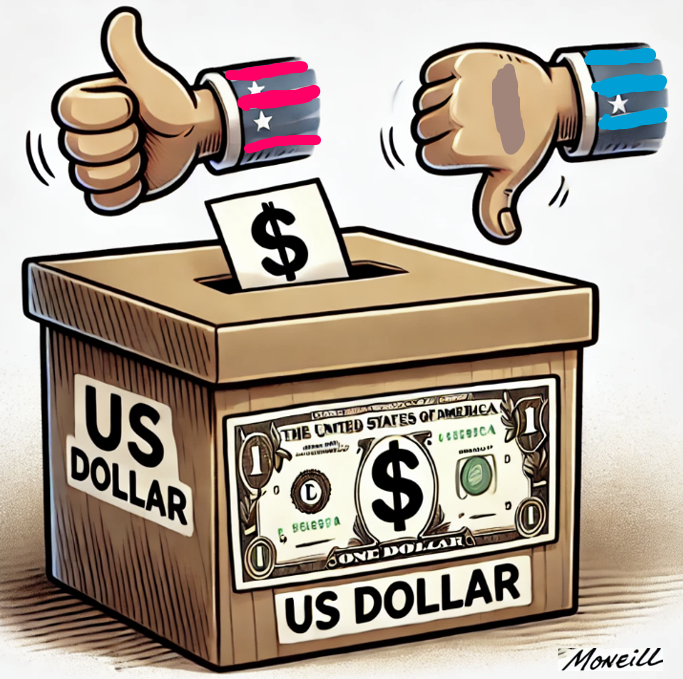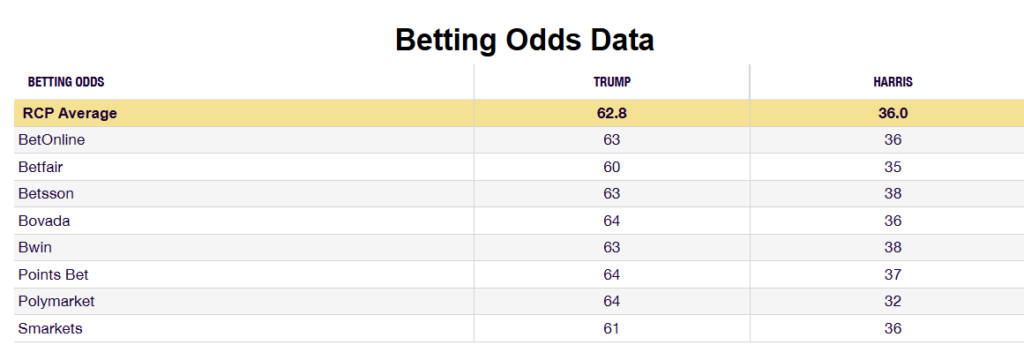
By Michael O’Neill
Finally! American’s are heading to the polls on November 5 and putting an end to the presidential campaign that essentially kicked off on January 6, 2020—a day remembered by Democrats as a coup attempt by former President Trump. Republicans see it differently, with many echoing Trump’s view that the election was rigged and the Capitol Hill riot merely free speech in action. Candidates who align with Trump on these points are also those aiming to curry favour and appointments.
FX traders do not care if the 2020 election was stolen. They are only concerned about how the outcome of the 2024 vote will impact the US dollar.
“Wanna Bet?”
Mainstream media polls report the Harris -Trump vote is too close to call. The betting polls do not see it that way. This sentiment is mirrored in the dollar’s recent rise, with the U.S. index climbing from 99.80 to 104.40 since early October—a gain of 4.06%.
That’s because the bettors expect the incoming administration to keep and expand on the policies from Trump’s 2016-2020 tenure. Mr Trump embraced tariffs with enthusiasm, and he plans to up his game if re-elected. All imports would get slapped with a 20% levy except those from China-they will face 60% import duties. His ultimate goal is to force factories to return to the US. It is not a bad idea. China is still the world’s factory and has become extremely rich over the past decade while adopting a belligerence to match its wealth. That belligerence includes claiming almost all of the South China Sea, threatening and harassing the sovereign nation of Taiwan and continuously supporting enemies of the US and democracy. The downside is a global trade war where every country implements tariff policies of their own.
Donald Trump abhors paying taxes and he floated the idea of scrapping federal income taxes and using new tariff cash to replace the lost income. There are no real details on the idea, but the plan is appealing to a large swathe of taxpayers.
Kamala Harris’s 2024 tax plan contrasts sharply, building on Biden-era initiatives. Her plan seeks to boost government revenue through higher taxes on corporations and wealthy individuals, while expanding tax credits for lower-income households. Key proposals include raising the corporate tax rate to 28%, implementing a 25% minimum tax on billionaires’ unrealized gains, and setting a 28% top rate on capital gains for those earning over $1 million. These measures would help finance the expanded social programs she champions.

Source: realclearpolling.com
Role Play Plays a Role
It’s not your grandfather’s party. Historically Republican’s were viewed as the fiscally-responsible stewards of the economy while Democrats never met a tax dollar or an increase in tax dollars that didn’t need to be spent. That changed in the 1980’s when Democrat President Bill Clinton donned the financial restraint hat, promoted balanced budgets, before handing a budget surplus to Republican President George W Bush. The Iran and Iraq wars made short work of that money. The Cost of War Project at Brown University estimates that the US spent $4.16 trillion on bombs, bullets and the like.
The 2024 presidential campaign highlights massive spending plans from both camps, with Donald Trump also proposing tax cuts. Such a plan isn’t generally favorable for a nation’s currency. Just ask former UK Prime Minister Liz Truss and her Chancellor, Kwasi Kwarteng. Their similar approach in 2022 sent UK bonds and currency into a tailspin, making Truss’s term the shortest in UK history, ending after just 44 days.”
It’s Different This Time
It appears that FX traders are not overly concerned about ‘Trump 2.0’ or a sharp rise in deficit spending. They seem confident that the U.S. dollar will come out ahead in any trade war, even a global one. The U.S. economy is the world’s largest by GDP, 50% larger than its closest competitor, China. Having the dollar as the world’s reserve currency adds another layer of security. The FX market suggests that Trump’s proposed business-friendly, low-tax regime will attract foreign capital as both an investment opportunity and a safe haven in the event of a global trade war.”
The Devil You Know

FX trading around the U.S. election is mostly sleight of hand and misdirection. The risk/reward is a moving target, often at the whim of one presidential candidate. Donald Trump does not have a filter. He says the most outrageous things and presents ‘fiction as fact.’ He’s a combative, elderly egomaniac, but traders like him because he is a known quantity. In contrast, Kamala Harris has a very small profile and is seen by many as the “that’s all we got” candidate due to Biden’s abrupt withdrawal. She was more or less appointed rather than elected and has only been campaigning since August 2. The devil you know…”
Reality Check
For FX traders, the election is only the appetizer; the main course is the November 7 FOMC meeting. While Fed Chair Powell insists rate cuts aren’t imminent, futures markets have already priced in a 25-bp cut. As long as other G7 central banks cut deeper and faster than the Fed, interest rate differentials will keep the dollar in demand.
The greenback may get a boost from the ballot box, but it’s the Fed that will decide if that boost becomes a bust.





